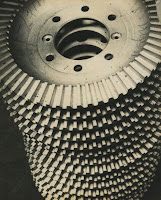The Last Futurist Exhibition (1915) showed a series of paintings with basic geometric shapes isolated or in groups on plain backgrounds.
The most austere painting from this exhibition, is regarded among the most radical paintings of its day, yet it is not impersonal; the trace of the artist’s hand is visible in the texture of the paint and the subtle variations of white.
Two of the most interesting points pointed out in the Suprematist Manifesto of 1915 were:
“But a tree remains a tree even when an owl builds a nest in a hollow of it” and “The artist (the painter) is no longer bound to the canvas (the picture plane) and can transfer his compositions from canvas to space.”
Alexander Rodchenko worked as a painter and graphic designer before turning to photomontage and photography. He wrote: "One has to take several different points of view and in different points of view and in different situations, as it one examined it in the round rather than looked through the same key-hole again and again." Over 70% of the Russian population could neither read or write. Lenin had suggested during the civil war that each of his soldiers should carry not just a weapon, but a camera too, and by 1924, having worked mainly with paint, Rodchenko took this art form on. He said later, "It would seem, that only the camera is capable of reflecting contemporary life."
Dive 1936
Gears 1929
Girl with a lieca 1934
El Lizitsky’s first Suprematist book is a story about how two squares, one red, one black, transform a world. The story of two squares, which was written in Russian and dedicated 'to all children', demonstrates the Suprematist integration of material and spatial that would later define the modern graphic arts. The story of 2 squares celebrates a moment in which the possibility of a better world seemed to lie ready and waiting for a young generation experienced in their imagination.
Overall, I believe the Constructivists similar to the Futurists, but just had new perspectives. They had a new take on art based on geometric shapes and mathematics. They made art with a purpose, and this purpose is continually used today. I believe Constructivists are more inspirational to the Graphic Arts, due to their use of geometric shapes etc, but it is still a useful movement to look at for every aspect of art and history.






No comments:
Post a Comment